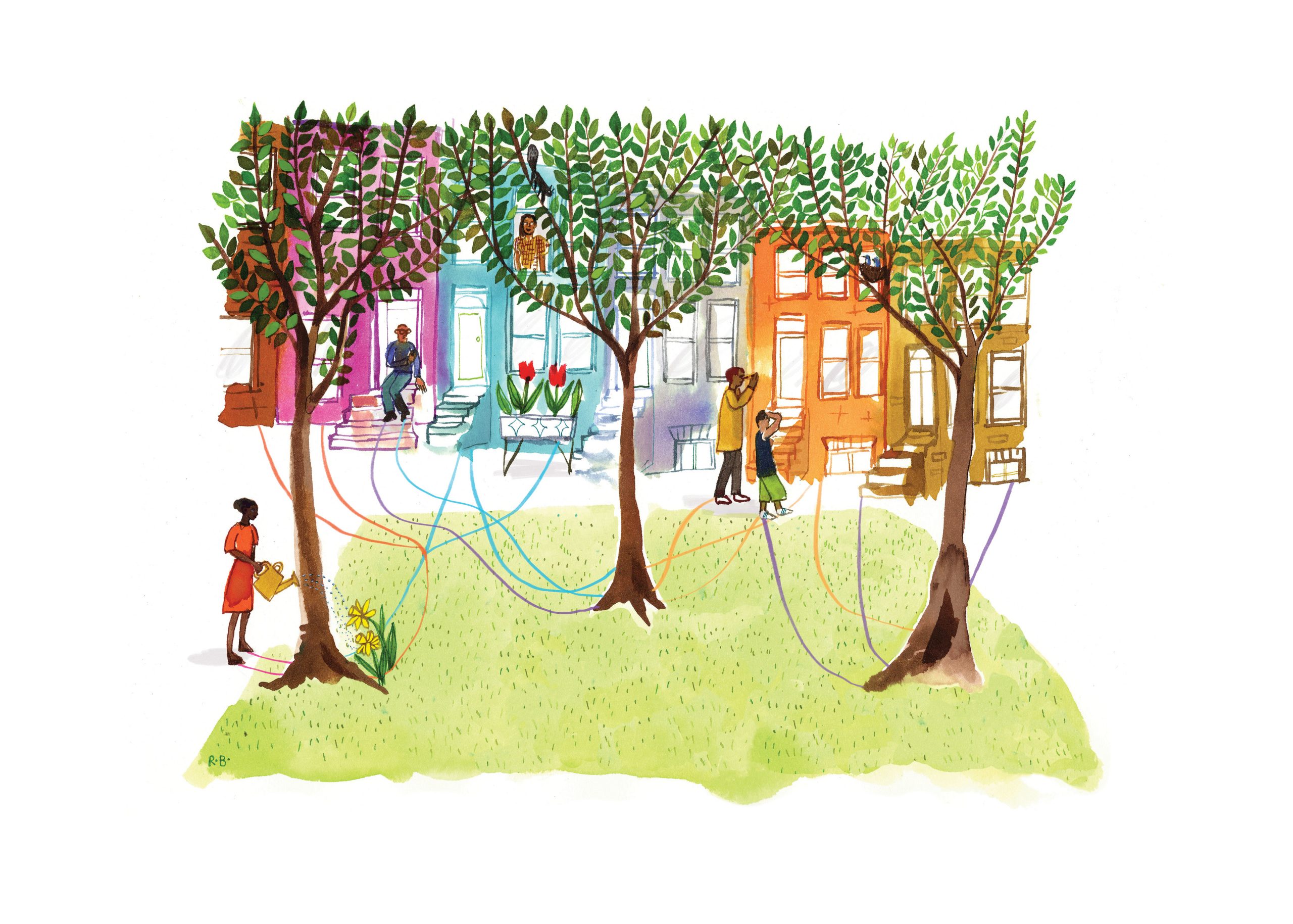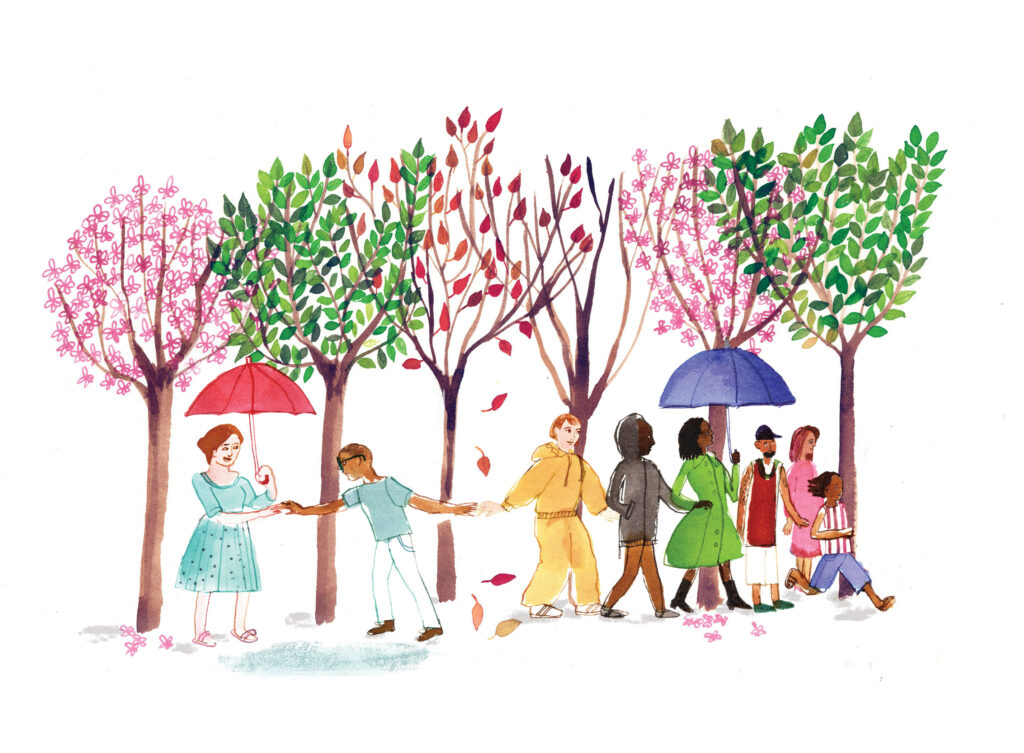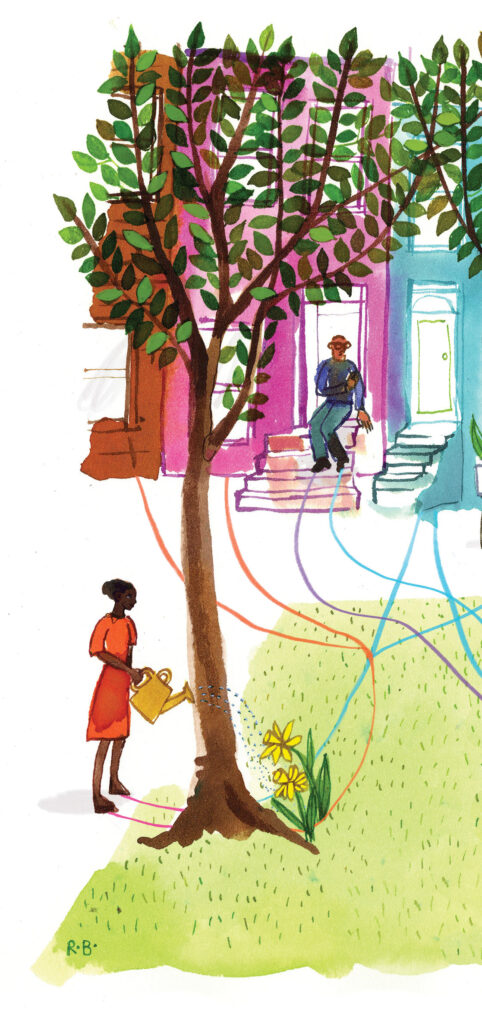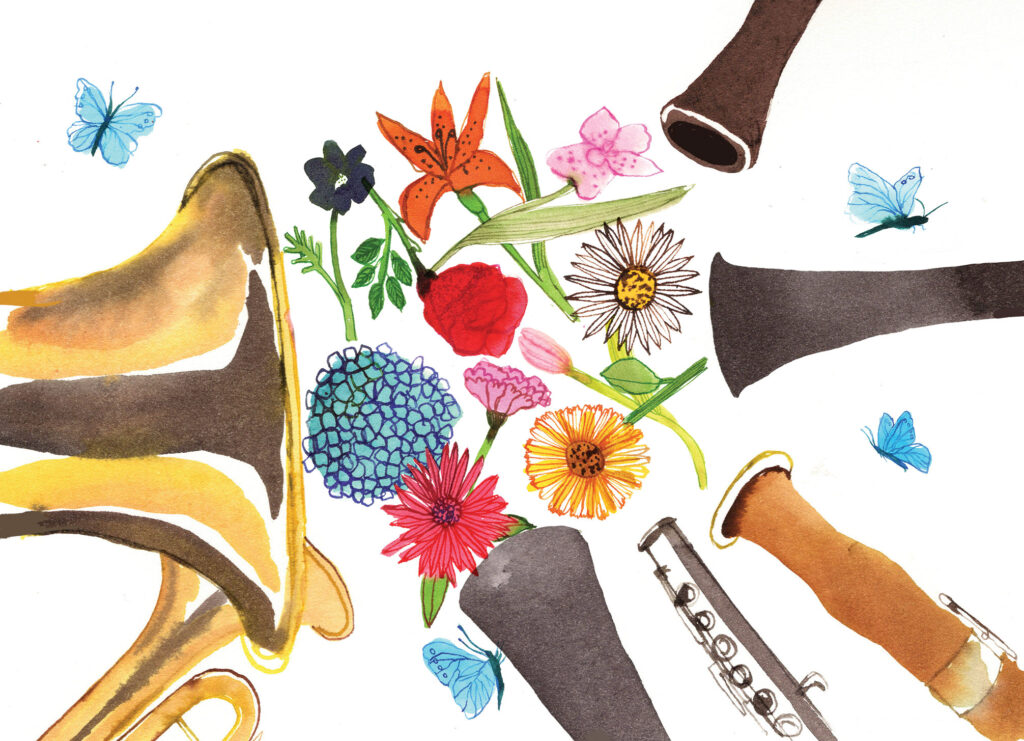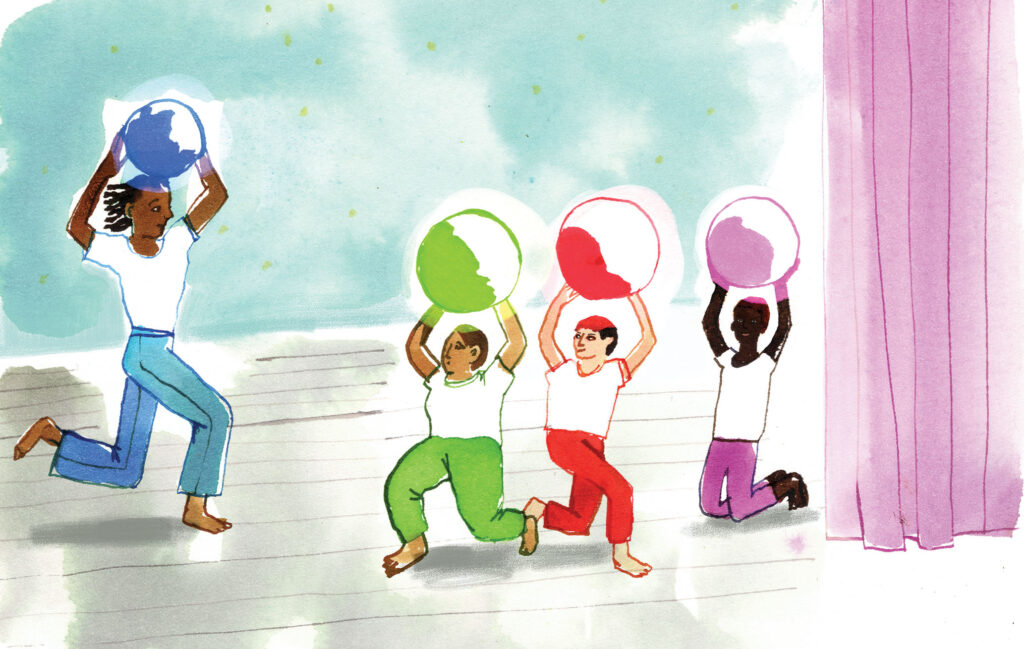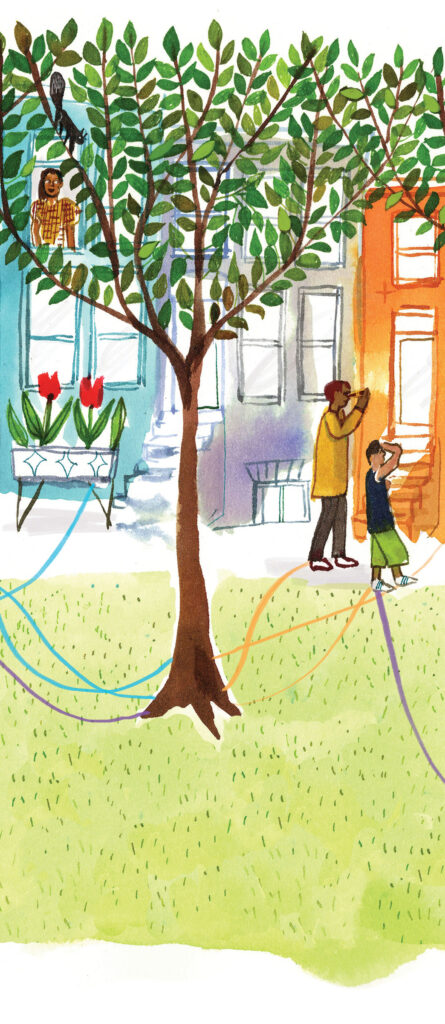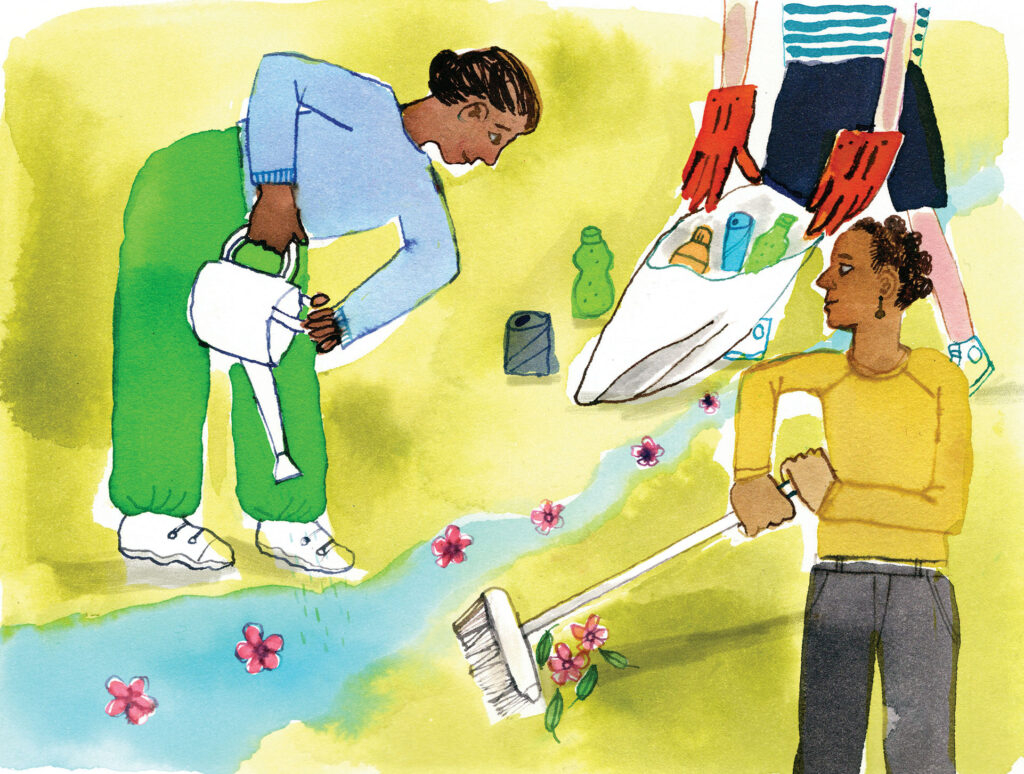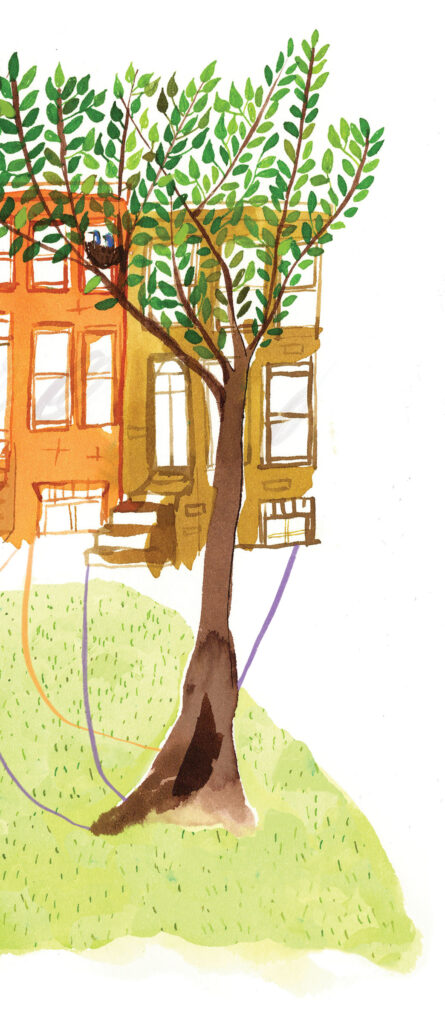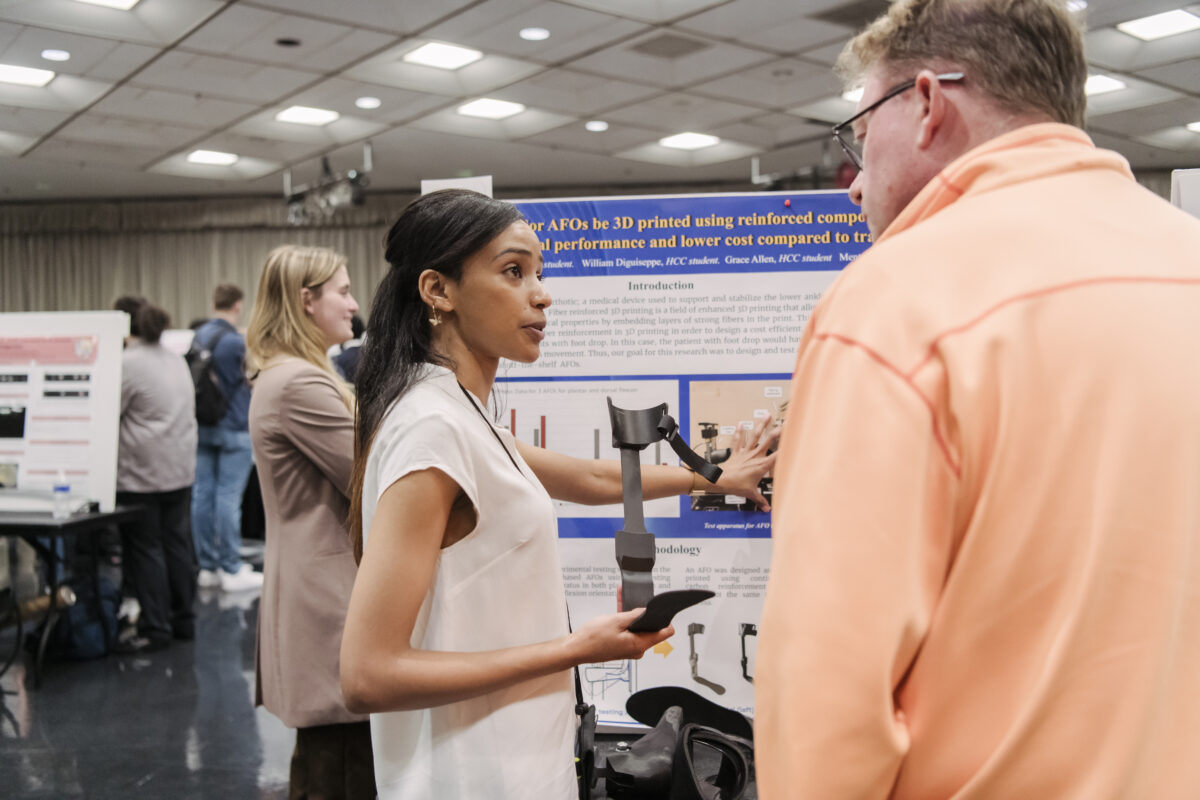In music, science, and theatre classes, in research labs, in conservation efforts, and almost every corner of academia, there’s a growing awareness and dedication to community-engaged scholarship. How are different disciplines training up social justice-minded students to do no harm to the communities they work in? With one thriving relationship at a time.
A tree grows in Baltimore. Its roots push against the surface, its newly budding canopy blocks some of the dreary rain on this last day in March. The aphorism promises flowers soon, but the daffodils are already here, lush and golden against the wet grass. Rooted in this environment, the tree struggles to absorb water in a heavily-paved area. It faces possible invasive species, the whims of developers, a strike of lightning or disease.
These outside influences affect the flourishing of this tree, and the flourishing of the neighborhood it’s rooted in is just as interconnected. A tension, a balance, a system of reciprocity.
In Franklin Square Park, on a parcel of land donated by developers to the southwest Baltimore neighborhood in 1839, this tree and 96 others were recently surveyed by UMBC students at the request of the Franklin Square Neighborhood Association. They wanted a catalog of their natural resources, but also a record of what they’ve lost—only seven of the original 149 trees on a 1916 map of the park remain.
Working with members of the neighborhood, Mariya Shcheglovitova, Ph.D. ’20, geography and environmental systems, and Bee Brown ’21, environmental science, and other UMBC student researchers began their work. Their project would rapidly expand from an arboreal park survey to a community-focused project that invited local kids to participate in a scavenger hunt and other activities to build on the students’ existing connection to the park. As Shcheglovitova and Brown discovered, “understanding park quality is dynamic and can only be partially captured in a survey of the park features. Historic accounts and a focus on what happens in a park can enrich our understanding of park quality.”
What began in Franklin Square as an effort to catalog trees—separate trunks with roots and canopies equally intermingling—broadened to encompass the community who interacts with the park the most. Acknowledging this interconnectedness in research of all types at UMBC is not new to academia but is becoming a more prominent approach to research as different disciplines wrestle with ways to train up social justice-minded students and do no harm to the communities they work in.
Bridging campus and community
Community-engaged research gives a name to this method. At UMBC, most service-learning and community engagement experiences are facilitated through The Shriver Center, which was founded nearly 30 years ago. Director Michele Wolff explains that in the early days, the Center emphasized “that higher ed institutions shouldn’t tell communities what they need. The partnership should be one of mutuality and reciprocity. So our focus should be listening to community partners, hearing where their gaps are and then being a resource to work with them to fill the gaps.”
This is still the Center’s primary mission, and in January 2020, the Carnegie Foundation for the Advancement of Teaching honored UMBC with its distinguished Carnegie Community Engagement Classification, acknowledging UMBC faculty, staff, students, and partners for their deep commitment to strengthening the bonds between campus and community.
As part of the application process, more than 120 campus partners and dozens of community partners underwent a rigorous self-study. Along the way, they found that in music, science, and theatre classes, in research labs, in conservation efforts, and almost every corner of academia, there’s a growing awareness and dedication to community-engaged scholarship. Wolff sees this movement come alongside “an increased appreciation of disparities, racial inequities, and other social justice issues. At the same time, people have been working on increasing appreciation and inclusion of community members as experts, or thinking about what counts as scholarly work.”
Some departments are working on ways to adopt these methods, and others have this ethos baked into their core. American studies, one of the original majors at UMBC, calls community-based research and engagement one of the “signatures” of the major. With its joint focus on “coupled natural and human systems,” geography and environmental systems (GES) is another department that recognizes the necessity and power of community-engaged scholarship.
Slow scholarship
“In the field of environmental justice, it’s absolutely assumed and expected that you’re going to do community-engaged research,” says Dawn Biehler, a GES professor who first became aware of the concept as a graduate student. “More and more people are realizing that this is important and a good way of doing research, but to do it really well takes so much time and you have to be brave, in a way.”
As an academic, says Biehler, you have to honestly assess if your career—the timing of publications and tenure-track expectations—will suffer from this process. “It takes time to build genuine relationships with the community,” she continues. After engagement and research, then you still need to publish, and all of this takes more time than many instructors have allotted in their balance of research and teaching. “The other thing you have to recognize is that the people in the community you’re working with, they’re exposed to risks all the time, just a different set of risks,” says Biehler.
Institutionally, UMBC is changing to reflect community-engaged research as a priority. In May 2019, the Faculty Senate successfully proposed new language to include evaluation of community-engaged scholarship in the promotion and tenure policy for all departments, says Donald Snyder, chair of the committee that spearheaded the policy change and a lecturer in media and communications studies.
Still, even with the university’s acknowledgement of this methodology, why would professors or students voluntarily choose the inherently riskier, if not just slower, approach to research?
Wolff highlights two affective or social emotional competencies she hopes students take from their time in community work—perspective taking and shared humanness. “What better place to develop and grow (those competencies) than in experiences where you have the opportunity to work with others who are different from yourself and in contexts that are different from the ones you’re used to?” asks Wolff.
Intersectional research
As a doctoral student, Shcheglovitova was known as “the person who cared about trees and social justice in the city,” so she wasn’t surprised when undergraduate student Bee Brown approached her to collaborate on a research project that interwove those topics.
Biehler’s multi-year connection with the Franklin Square community, says Shcheglovitova, gave neighborhood folks someone to approach who was willing to listen and respond about local environmental issues and allowed her and Brown to more easily gain the trust of the people involved.
Scott Kashnow, vice president of the Franklin Square Neighborhood Association, wanted an updated survey of the park’s trees that could inform future plantings in the park. Looking at historical photos and a 1916 map of the park, it’s clear a lot has changed in the past 100 years. Park features have disappeared or degraded—the once bubbling fountain is planted over, the park bathroom is boarded shut, and many of the area’s ash trees were decimated by an invasive insect species.
After the survey was completed, Kashnow came up with the idea to invite students from a local school to celebrate the work and take part in the ongoing research. Shcheglovitova, Brown, and Biehler took the opportunity to gain a deeper understanding into community relationships with the park space.
“This is a way research can actually be helpful to the community,” says Kashnow, a Franklin Square resident for 14 years. “Through various organizations, we’ve been studied so much and oftentimes the studies don’t make any tangible difference in people’s lives. And people are still very happy to participate, you know, everybody has opinions, they love to talk about them. But does the research actually translate to some difference in people’s lives?”
Orchestrating social change
Regardless of the discipline, successful community-engaged scholarship depends on sustained relationships over time. Brian Kaufman, associate professor of music, sees grade school music teachers as great examples of this practice. Unlike other academic subjects in grade school where students have new instructors each year, music teachers interact with the same student musicians year after year. So it naturally follows for Kaufman that his music education students at UMBC should commit to a school for longer than a semester.
Through the Baltimore Symphony Orchestra initiative OrchKids (and with the support of The Shriver Center), UMBC students work with Kaufman at Booker T. Washington Middle School in West Baltimore for two years at a time. “It’s unusual for student teachers to spend four semesters at the same school, but to really build relationships with students, to see them develop, this is necessary,” Kaufman says, not just for the middle school students, but his UMBC students as well.
Pre-COVID, (although they have continued the program virtually) this would mean seven to 10 site visits to the school per semester. UMBC students spend the first half of the visit observing the teacher or engaging with the class, and the last hour spent in guided reflection.
“To me,” shares Kaufman, “that’s where the juicy part comes in.” Before heading back to campus in a Shriver Center van, Kaufman says, “we sit down and talk about what we learned. And we really try to unpack our experience and make connections to some bigger issues—issues of equity, and these larger discussions about teaching in the field and service-learning in the city and how these things tie together. That’s where the real richness comes in for the students.”
Science on the stage
If music education lends itself naturally to following a community-engaged process, what about cross-disciplinary initiatives like Erin Lavik and Lynn Watson’s project Theatre Arts and Communicating Science? Lavik, professor in the department of chemical, biochemical, and environmental engineering, and Watson, a theatre professor, collaborated with Arbutus Middle School science teachers to use theatre skills—playwriting, improvisation, and voice/speech—to help their young students tell stories about their capstone science projects.
Lavik had personally experienced the powerful interplay between STEM and theatre in her own studies, she says, “So I wanted to create a program that helped college students tell the story of their science and let them engage with students in middle school who were vulnerable to losing their passion in science.” When she approached Watson about the idea, the theatre professor was thrilled. “We shared an understanding of the power of theatrical storytelling that can bring communities of people together,” says Watson.
Prior to the program, the UMBC undergraduate and graduate engineering and theatre students spent a preparatory weekend workshopping with science teachers at Arbutus Middle School. Lavik and Watson saw the Retrievers’ confidence and community-building efforts gain steam over the weekend which led to a more successful outcome when they worked with the middle schoolers.
The students ultimately used a playwriting exercise to understand the plight of endangered species and improv scenarios to demonstrate the real world effects of Newton’s Laws of Motion—all of this performed with joy, says Watson. She noticed that the experience also “had a tremendous impact on the UMBC students in terms of confidence in their abilities as leaders and their ability to take action in contributing to the wider community, including outside the university.”
Before their joint project in January 2020, Lavik and Watson were both interested in the concept of community-engaged programming, but they attribute the successful launch of their vision to The Shriver Center. After the fact, Lavik observed that community-engaged scholarship can increase student retention—the stipends attached to the program, made possible by a Charlesmead Initiative for Arts Education grant, afforded students the time to participate. “I hope that over time, we will be able to show that programs that integrate arts and science can help students thrive at UMBC, and bringing these programs to our communities can increase the number of students, particularly from underrepresented populations, who can begin to see themselves as scientists and engineers with joy.”
Changing university culture
UMBC’s Center for Democracy and Civic Life has been instrumental in creating a campus culture of an engaged community—promoting equitable off-campus partnerships while emphasizing the importance of starting that process within the communities at UMBC. The Center’s Director David Hoffman, Ph.D. ’13, language, literacy, and culture, and Assistant Director Romy Hübler ’09, MLL, M.A. ’11, intercultural communications, Ph.D. ’15, LLC, say that an initiative that precedes the formalization of the Center is the BreakingGround grant program.
The origins of BreakingGround came from an effort to organize a UMBC Civic Year in 2012, says Hoffman, when “we discovered all of these people who were doing amazing things.” Greg Simmons, M.P.P. ’04, vice president of institutional advancement, challenged the group to think bigger, remembers Hoffman. “He said, ‘you know, you’re talking about this as a year, but this really is about UMBC’s identity. This is a place where we come together because we want to change the world and we want to change it in particular ways that align with values like inclusive excellence.’”
Hoffman, along with Wolff and others, recognized that community-engaged work was happening in classrooms, at service-learning sites, and in other campus settings, but there wasn’t a unifying structure for like-minded people to find each other easily. Through a sustaining grant from the provost’s office, BreakingGround has offered grants to 80 applicants to infuse courses and programs with opportunities for students to develop civic agency, and to shape their experiences so they’re not “just a one-off community service project, but an opportunity for lasting community engagement,” says Hoffman.
Hübler joined the BreakingGround working group in 2012 as the community liaison for the Graduate Student Association, and as a result of her involvement changed the topic of her dissertation. “I noticed among graduate students from all these different disciplines that many of us were drawn to our topics of study because we either had personal experience with them or we lived in communities where we would observe the effects of bad policy on people and centuries of oppression and marginalization.”
In 2013, UMBC began sending delegations to the Imagining America conference, which, according to the group’s mission, brings together people in higher education, non profit organizations, and activists to “imagine, study, and enact a more just and liberatory ‘America’ and world.” Imagining America’s leaders were struck by the holistic vision described by UMBC participants. “They saw how we were changing the university’s culture,” says Hübler. “Like this was not just one faculty member doing this in this discipline and another one over here, and they’re not communicating, but they could see that this was an organized effort.”
As a result, UMBC was asked to bring the 2015 conference to Baltimore. Hübler and others began to reach out to partners to co-organize workshops around the city. “What is the story that we want to tell of Baltimore?” Hübler would ask. “We didn’t want it to be UMBC saying, ‘this is the story,’ right? But we came up with the story together.” In between planning the conference and the actualization of the work, Freddie Gray died in police custody in April 2015. Uprisings shook the city and caused UMBC to conduct a campus-wide inventory of Baltimore-based engagement, and that accounting ultimately strengthened the intentionality to focus community-based activities on racial equity. One of the most significant outcomes of that reckoning would come in 2017, with the establishment of the Truth, Racial Healing, & Transformation Campus Center at UMBC, which works to break down racial hierarchies with a focus on the university’s service-learning and community-engagement partnerships in Baltimore City.
Importantly, Hübler notes that UMBC is, in fact, its own community and should apply the same community-engaged best practices internally. “There are challenges we have,” she says, “and UMBC can be better. We are constantly making and co-creating UMBC. Students are not just customers floating through to get a degree, but we all have responsibility for our own community. And if we want to co-create our space, there are skills, knowledge, and dispositions that we need that are pretty much the same as what we need when we work with communities elsewhere.”
Good stewardship
Alumna Briana Yancy always envisioned herself following a typical research path, as she thought of it, a scientist in a lab. So she was surprised when she found herself on her third trip to the Bahamas as a part of biological sciences Professor Kevin Omland’s lab studying the Bahama Oriole. Yancy and the other students working with Omland partnered with The Bahamas National Trust, and she says the local community was always excited to talk about their orioles, showing them nests and asking insightful questions.
“I started to see how important this community connection is,” says Yancy, now the diversity work group staffer at the Chesapeake Bay Program, a collective of organizations whose shared mission is to protect the Chesapeake Bay. “It’s important that scientists and researchers learn how to work with local communities and how to talk about the things that they’re working on, especially for the environmental field, because it impacts everybody. If you can’t articulate that, people aren’t going to care and they’re not going to try to make a difference or get involved.”
Yancy ’19, M27, environmental science, says Omland set an example in the Bahamas that she’s tried to emulate since in her own work. “He always made sure to invite people along, to take the time to explain things to people, and also stop to get their insight,” says Yancy. As an intern at the National Aquarium checking water quality in the harbor, Yancy remembers, “people would always come up to me and be like, ‘Oh, what are you doing?’ And I would take the time to explain to them, ‘I’m doing this. This is what this machine is called. And this is how I do it, the numbers I’m looking for, and why it’s important.’”
In her current position, Yancy sees an increased attention toward community-engaged research as organizations like the Chesapeake Bay Program ask themselves how they can reach a more diverse audience. “If we keep getting engagement from the same people from the same walks of life, we’re going to miss things,” says Yancy. “And we really can’t afford to miss anything. Climate change is now and the environment is struggling. And I think that, especially with COVID, we’re seeing more clearly the intricate connection between environmental health and public health.”
Moving toward the ideal
What does it mean to engage in relationships that encourage mutual flourishing? How can the roots and the canopy both benefit and nourish the good of the one tree? This is a question The Shriver Center and their partners at UMBC have been asking themselves and the thousands of students who use the Center’s service-learning structure to engage with the surrounding Baltimore County and City communities for the past 30 years.
Wolff sees community-engaged scholarship as a step away from transactional partnerships to transformational ones. The ideal, she says, should be to include the community from start to finish so everyone benefits.
“We’re recognizing community members as experts and moving forward with a goal of reciprocity and mutuality in our work,” says Wolff. “Part of the ideal is having community members be a part of every aspect of the activity. That’s where we want to get to. I think we’re moving toward that ideal.”
*****
Illustrations by Rebecca Bradley.
Tags: CAHSS, CBEE, Center for Democracy and Civic Life, environmental systems, GES, Music, professorsnottomiss, Spring 2021, the shriver center, Theatre

